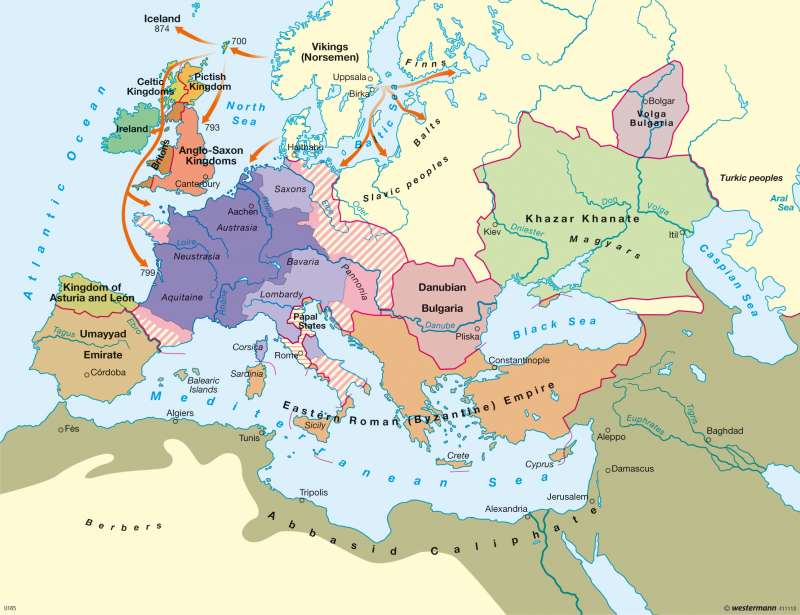Europe at the end of Charlemagne's reign circa 814
Europe - Middle Ages
978-3-14-100790-9 | Page 30 | Ill. 1

Information
The process of building the Frankish Germanic Empire began at the dawn of the High Middle Ages. The sphere of influence of the Franks under the ruling Carolingians encompassed nearly the whole of Western Europe. One of the greatest triumphs of Charlemagne's reign was the conquest of all Germanic tribal duchies and tribes and their unification, albeit only briefly, as an "imperial nation". It is no coincidence that a name for the language spoken by all Germanic tribes first appeared at that time: Thiudisk (German).Yet it was not long after Charlemagne's death that two conflicts that were characteristic of the early High Middle Ages began to emerge in the principalities and kingdoms of Europe. The first was the power struggle between the ruling monarchs and competing noble families. The ways in which this conflict was resolved had a significant impact on the later development of the European empires and nations. The second central conflict involved the rivalry between the secular rulers, who sought to expand their power and influence, and the Church's claims to autonomy and authority. Long before the call to liberate Christ's grave from the Arabs, the idea of a unified Christian Occident led to the dispute between the Pope and the Emperor known as the Investiture Controversy.
When Charlemagne took over as ruler of the Frankish Empire in 768 AD, it encompassed nearly all of the present nation of France and half of what is now Germany. Charlemagne's father Pepin III (the Younger) had deposed the Merovingian king in 751 and had himself elected king and anointed by the Pope. He succeeded in integrating the Duchies of the Bavarians, Allemanni and Thuringians within the Frankish kingdom and subjecting them to vassalage.
Charlemagne crossed the Alps in 773 and defeated the Lombards. In 778, he fought against the Spanish Moors and established the Spanish March on the Iberian Peninsula (795). In 787 he deposed the Bavarian Duke Tassilo III. Bavaria was stripped of its autonomy. Charlemagne then went to war with the Avars, an Asian warrior horde that had invaded Bavaria, and with the Slavs and Danes. The greatest military campaigns undertaken during Charlemagne's reign were the wars against the Saxons, which began in 772 and did not end until 804, following numerous victories and defeats, with the subjugation of the Saxons and their conversion to Christianity. In the fields of domestic and foreign policy, Charlemagne established the foundation for a cohesively structured empire.
The decline that began following his death set the stage for the plundering campaigns undertaken by Vikings from Scandinavia along the coast of Europe after the end of the 8th century. Norwegian Vikings began with attacks on the north-eastern coast of England and went on to occupy northern Scotland and Ireland. Several groups voyaged south along the Atlantic coastline to the Straits of Gibraltar and the coasts of the Mediterranean; others occupied the Shetland and Faroe Islands and Iceland. Danish Vikings attacked England and France and conquered Normandy. Swedish Vikings crossed the Baltic Sea and founded several kingdoms in coastal areas populated by Slavs.
Vikings advanced to the Middle-Rhine region in the latter half of the 9th century,. Having sacked Cologne, Bonn and Trier, they moved on to the Rhone Valley before proceeding into northern Italy. England was conquered by Vikings from all three Scandinavian kingdoms in 1016 AD. Fifty years later, Norman Vikings advanced as far as southern Italy and Sicily, where they established the Apulian and Sicilian Empires. Swedish Vikings (Varangians or Rus) marched along the Volga to the Caspian Sea and on to the Black Sea, Constantinople and Baghdad.
K. Lückemeier, E. Astor; Ü: J. Southard




